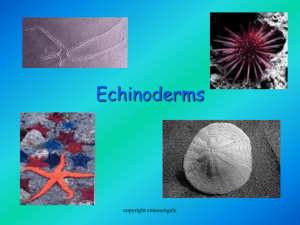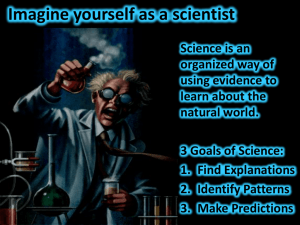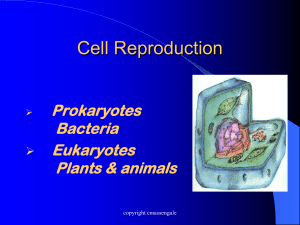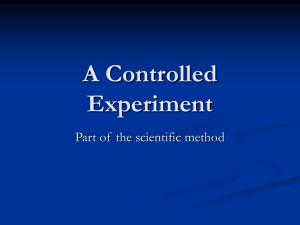Origin of life - Biology Junction
advertisement
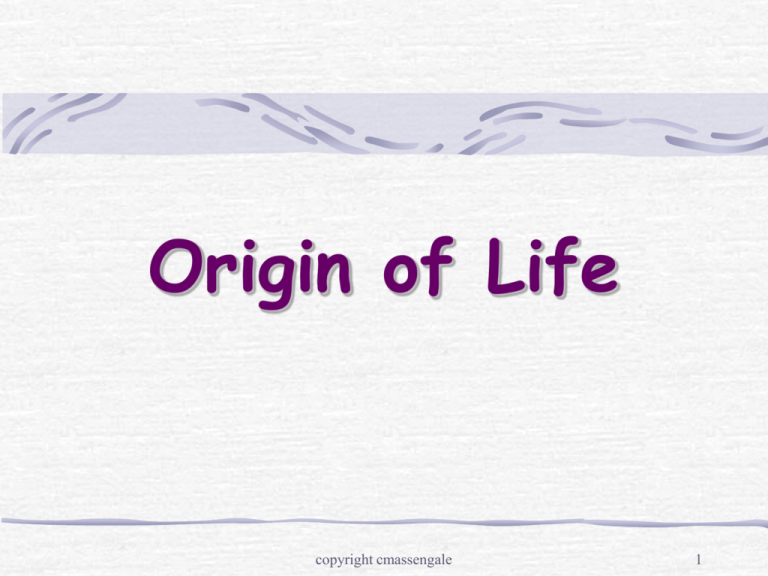
Origin of Life copyright cmassengale 1 Aristotle (384 –322 BC) Proposed the theory of spontaneous generation Also called abiogenesis Idea that living things can arise from nonliving matter Idea lasted almost 2000 years copyright cmassengale 2 copyright cmassengale 3 Spontaneous Generation For centuries, people based their beliefs on their interpretations of what they saw going on in the world around them without testing their ideas They didn’t use the scientific method to arrive at answers to their questions Their conclusions were based on untested observations copyright cmassengale 4 Examples of Spontaneous Generation copyright cmassengale 5 Example #1 Observation: Every year in the spring, the Nile River flooded areas of Egypt along the river, leaving behind nutrient-rich mud that enabled the people to grow that year’s crop of food. However, along with the muddy soil, large numbers of frogs appeared that weren’t around in drier times copyright cmassengale 6 Example #1 Conclusion: It was perfectly obvious to people back then that muddy soil gave rise to the frogs copyright cmassengale 7 Example #2 Observation: In many parts of Europe, medieval farmers stored grain in barns with thatched roofs (like Shakespeare’s house). As a roof aged, it was not uncommon for it to start leaking. This could lead to spoiled or moldy grain, and of course there were lots of mice around. copyright cmassengale 8 Example #2 Conclusion: It was obvious to them that the mice came from the moldy grain. copyright cmassengale 9 Example #3 Observation: In the cities centuries ago, there were no sewers, no garbage trucks, no electricity, and no refrigeration. Sewage flowed down the streets, and chamber pots and left over food were thrown out into the streets each morning. Many cities also had major rat problems and a disease called Bubonic plague. copyright cmassengale 10 Example #3 Conclusion: Obviously, all the sewage and garbage turned into the rats. copyright cmassengale 11 Example #4 Observation: Since there were no refrigerators, the mandatory, daily trip to the butcher shop, especially in summer, meant battling the flies around the carcasses. Typically, carcasses were “hung by their heels,” and customers selected which chunk the butcher would carve off for them. copyright cmassengale 12 Example #4 Conclusion: Obviously, the rotting meat that had been hanging in the sun all day was the source of the flies. copyright cmassengale 13 Abiogenesis Recipes Recipe for bees: Kill a young bull, and bury it in an upright position so that its horns protrude from the ground. After a month, a swarm of bees will fly out of the corpse. copyright cmassengale 14 Abiogenesis Recipes Recipe for mice: Place a dirty shirt or some rags in an open pot or barrel containing a few grains of wheat or some wheat bran, and in 21 days, mice will appear. There will be adult males and females present, and they will be capable of mating and reproducing more mice. copyright cmassengale 15 Disproving Spontaneous Generation copyright cmassengale 16 Francesco Redi (1668) In 1668, Francesco Redi, an Italian physician, did an experiment with flies and widemouth jars containing meat copyright cmassengale 17 Redi’s Experiment Redi used open & closed flasks which contained meat. His hypothesis was that rotten meat does not turn into flies. He observed these flasks to see in which one(s) maggots would develop. copyright cmassengale 18 Redi’s Findings He found that if a flask was closed with a lid so adult flies could not get in, no maggots developed on the rotting meat within. In a flask without a lid, maggots soon were seen in the meat because adult flies had laid eggs and more adult flies soon appeared. copyright cmassengale 19 Redi’s (1626-1697) Experiments Evidence against spontaneous generation: 1. Unsealed – maggots on meat 2. Sealed – no maggots on meat 3. Gauze – few maggots on gauze, none on meat copyright cmassengale 20 Results of Redi’s Experiments The results of this experiment disproved the idea of spontaneous generation for larger organisms, but people still thought microscopic organisms like algae or bacteria could arise that way. copyright cmassengale 21 Francesco Redi copyright cmassengale 22 Did Redi Use the Scientific Method? copyright cmassengale 23 The Scientific Method Observation Hypothesis Experiment Accept, Reject, or Modify hypothesis copyright cmassengale 24 Step 1 - Observation There were flies around meat carcasses at the Butcher shop. Where do the flies come from? Does rotting meat turn into or produce rotting flies? copyright cmassengale 25 Step 2 - Hypothesis Rotten meat does not turn into flies. Only flies can make more flies. copyright cmassengale 26 Step 3 - Testing Wide-mouth jars each containing a piece of meat were subjected to several variations of “openness” while all other variables were kept the same. Control group — These jars of meat were set out without lids so the meat would be exposed to whatever it might be in the butcher shop. Experimental group(s) — One group of jars were sealed with lids, and another group of jars had gauze placed over them. copyright cmassengale 27 Step 4 - Data Presence or absence of flies and maggots observed in each jar was recorded. Control group – flies entered, laid eggs, & maggots emerged Gauze covered – flies on gauze, but not in jar Sealed jars – No maggots or flies on the meat copyright cmassengale 28 Step 5 - Conclusion Only flies can make more flies. In the uncovered jars, flies entered and laid eggs on the meat. Maggots hatched from these eggs and grew into more adult flies. Adult flies laid eggs on the gauze on the gauzecovered jars. These eggs or the maggots from them dropped through the gauze onto the meat. In the sealed jars, no flies, maggots, nor eggs could enter, thus none were seen in those jars. Maggots arose only where flies were able to lay eggs. This experiment disproved the idea of spontaneous generation for larger organisms. copyright cmassengale 29 Disproving Spontaneous Generation of Microbes copyright cmassengale 30 Anton van Leeuwenhoek (1674) Leeuwenhoek began making and looking through simple microscopes He often made a new microscope for each specimen He examined water and visualized tiny animals, fungi, algae, and single celled protozoa; “animalcules” By end of 19th century, these organisms were called microbes copyright cmassengale 31 Anton van Leeuwenhoek 1632-1723 copyright cmassengale 32 Leeuwenhoek’s Microscope copyright cmassengale 33 John Needham (1745) Showed that microorganisms flourished in various soups that had been exposed to the air Claimed that there was a “life force” present in the molecules of all inorganic matter, including air and the oxygen in it, that could cause spontaneous generation to occur copyright cmassengale 34 Needham’s Results Needham’s experiments seemed to support the idea of spontaneous generation People didn’t realize bacteria were already present in Needham’s soups Needham didn’t boil long enough to kill the microbes copyright cmassengale 35 Needham’s Experiment copyright cmassengale 36 Lazzaro Spallanzani’s (1765) Boiled soups for almost an hour and sealed containers by melting the slender necks closed. The soups remained clear. Later, he broke the seals & the soups became cloudy with microbes. copyright cmassengale 37 Spallanzani’s Results copyright cmassengale 38 Conclusion Critics said sealed vials did not allow enough air for organisms to survive and that prolonged heating destroyed “life force” Therefore, spontaneous generation remained the theory of the time copyright cmassengale 39 The Theory Finally Changes copyright cmassengale 40 How Do Microbes Arise? By 1860, the debate had become so heated that the Paris Academy of Sciences offered a prize for any experiments that would help resolve this conflict The prize was claimed in 1864 by Louis Pasteur, as he published the results of an experiment he did to disproved spontaneous generation in microscopic organisms copyright cmassengale 41 Louis Pasteur (1822-1895) copyright cmassengale 42 Pasteur's Problem Hypothesis: Microbes come from cells of organisms on dust particles in the air; not the air itself. Pasteur put broth into several special S-shaped flasks Each flask was boiled and placed at various locations copyright cmassengale 43 Pasteur's Experiment - Step 1 S-shaped Flask Filled with broth The special shaped was intended to trap any dust particles containing bacteria copyright cmassengale 44 Pasteur's Experiment - Step 2 Flasks boiled Microbes Killed copyright cmassengale 45 Pasteur's Experiment - Step 3 Flask left at various locations Did not turn cloudy Microbes not found Notice the dust that collected in the neck of the flask copyright cmassengale 46 Pasteur's Experimental Results copyright cmassengale 47 The Theory of Biogenesis Pasteur’s S-shaped flask kept microbes out but let air in. Proved microbes only come from other microbes (life from life) - biogenesis copyright cmassengale Figure 1.3 48 Review copyright cmassengale 49 Evidence Pro and Con 1668: Francisco Redi filled six jars with decaying meat. Conditions: Results: 3 jars covered with fine net No maggots 3 open jars Maggots appeared From where did the maggots come? What was the purpose of the sealed jars? Spontaneous generation or biogenesis? copyright cmassengale 50 Evidence Pro and Con 1745: John Needham put boiled nutrient broth into covered flasks. Conditions: Nutrient broth heated, then placed in sealed flask Results: Microbial growth From where did the microbes come? Spontaneous generation or biogenesis? copyright cmassengale 51 Evidence Pro and Con 1765: Lazzaro Spallanzani boiled nutrient solutions in flasks. Conditions: Results: Nutrient broth No microbial placed in flask, growth heated, then sealed Spontaneous generation or biogenesis? copyright cmassengale 52 Evidence Pro and Con 1861: Louis Pasteur demonstrated that microorganisms are present in the air. Conditions: Results: Nutrient broth placed in Microbial growth flask, heated, not sealed Nutrient broth placed in No microbial growth flask, heated, then sealed Spontaneous generation or biogenesis? copyright cmassengale 53 copyright cmassengale 54

